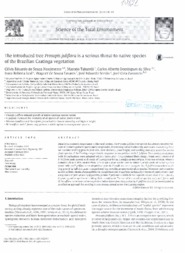The introduced tree Prosopis juliflora is a serious threat to native species of the Brazilian Caatinga vegetation.
The introduced tree Prosopis juliflora is a serious threat to native species of the Brazilian Caatinga vegetation.
Autoria: NASCIMENTO, C. E. de S.; TABARELLI, M.; SILVA, C. A. D. da; LEAL, I. R.; TAVARES, W. de S.; SERRÃO, J. E.; ZANUNCIO, J. C.
Resumo: Despite its economic importance in the rural context, the Prosopis juliflora tree species has already invaded millions of hectares globally (particularly rangelands), threatening native biodiversity and rural sustainability. Here we examine seedling growth (leaf area, stem diameter, plant height) and seedling mortality across five native plant species of the Caatinga vegetation in response to competition with P. juliflora. Two sowing treatments with 10 replications were adopted within a factorial 2 × 5 randomized block design. Treatments consisted of P. juliflora seeds sowed with seeds of Caesalpinia ferrea, Caesalpinia microphylla, Erythrina velutina, Mimosa bimucronata and Mimosa tenuiflora (one single native species per treatment), while seeds of native species sowed without P. juliflora were adopted as controls. Overall, our results suggest that P. juliflora can reduce seedling growth by half and cause increased seedlingmortality amongwoody plant species.Moreover, native species exhibit different levels of susceptibility to competitionwith P. juliflora, particularly in terms of plant growth. Such a superior competitive ability apparently permits P. juliflora to establishmonospecific stands of adult trees, locally displacing native species or limiting their recruitment. The use of less sensitive species, such as C. ferrea and M. tenuiflora, to restore native vegetation before intensive colonization by P. juliflora should be investigated as an effective approach for avoiding its continuous spread across the Caatinga region.
Ano de publicação: 2014
Tipo de publicação: Artigo de periódico
Unidade: Embrapa Semiárido
Palavras-chave: Algaroba, Biodiversidade, Caatinga, Espécie Nativa, Floresta, Forestry, Invasão de plantas, Prosopis Juliflora, Vegetação
Observações
1 - Por padrão são exibidas publicações dos últimos 20 anos. Para encontrar publicações mais antigas, configure o filtro ano de publicação, colocando o ano a partir do qual você deseja encontrar publicações. O filtro está na coluna da esquerda na busca acima.
2 - Para ler algumas publicações da Embrapa (apenas as que estão em formato ePub), é necessário ter, no celular ou computador, um desses softwares gratuitos. Sistemas Android: Google Play Livros; IOS: iBooks; Windows e Linux: software Calibre.
Acesse outras publicações
Acesse a Base de Dados da Pesquisa Agropecuária (BDPA) para consultar o acervo completo das bibliotecas da Embrapa.

